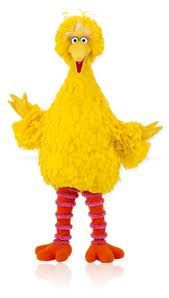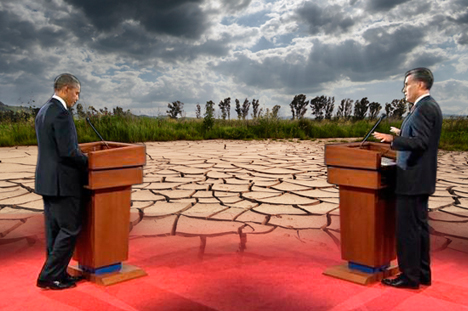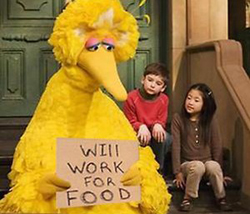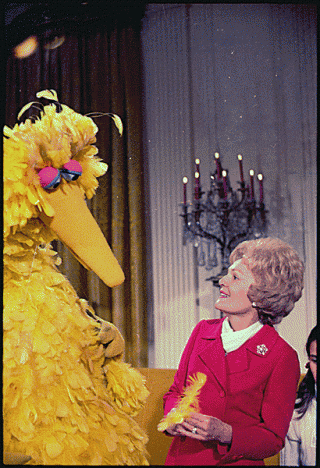
WATCH OUT FOR BIG BIRD
BIG BIRD AND POLITICS

|
12-2-15 - DREAM As the
dream started, ahead of me was a very tall grassy hill that was terraced
in multiple layers. On each layer stood a line of people standing
evenly spaced. These people were all wearing black clothing such
as worn in med 20th century - like 1960's or before. |
|
|
That made even more curious as to why Big Bird was with Michelle Obama.
This is what I found.
Geek Pride welcomes guest blogger Kevin O'Kelly, a writer whose work has appeared in the Boston Globe and the literary journal Alligator Juniper.
When Mitt Romney said he would "fire Big Bird" in the first presidential debate, he was threatening to cancel a show that has been proven crucial to the education of American children.
But the instructional benefits of Sesame Street go beyond basic vocabulary and math. Arguably, it also educates American children about an issue that will affect many of them as adults: mental illness. The characters on Sesame Street suffer from many of the disorders described in the American Pyschiatric Association's Diagnostic and Statistical Manual (DSM-IV).
Or as a college roommate of mine put it: "Sesame Street is nothing less than a window into madness."
Let's start with the obvious: Cookie Monster has an eating disorder and Count von Count is OCD. Grover, who sometimes thinks he's a superhero, has some kind of delusional disorder.
Ernie and Bert present more difficult cases. Most amateur psychologists on the Internet believe Ernie has a case of Attention Deficit Disorder, which accounts for some (but not all) of his bizarre behavior. Remember the time Bert couldn't sleep because of the sound of a dripping faucet, and Ernie's response was to turn on the radio to drown out the faucet?
I suspect some profound mental disability.
Bert's various compulsions and obsessions (exercising, collecting paper clips, the letter W) point to Obsessive Compulsive Personality Disorder. Individuals who suffer from OCPD often have intimacy issues, which would explain why Ernie and Bert have been sleeping in separate beds for forty years.
The contrasting personalities and behaviors of Ernie and Bert also serve as an introduction to Freud's concepts of the id and the superego. Ernie is all impulse; Bert is overly concerned with following rules.
There's no consensus on Oscar the Grouch. Some say Anti-Social Personality Disorder. But the author of the website A DSM-IV Look at Sesame Street disputes this diagnosis, making a compelling case that Oscar suffers from Oppositional Defiant Disorder.
And finally, let's turn to the character who embodies Sesame Street for most of us, Big Bird. He's usually diagnosed as a schizophrenic, given that for most of Sesame Street's history his best friend, the Snuffleupagus (who is often severely depressed), seems to have been a hallucination. That Snuffy became visible to everyone else on Sesame Street in 1985 would appear to undercut this assessment, but the author of A DSM-IV
Look argues that this is a case of Shared Psychotic Disorder, the transference of a delusion to others.
By now I'm sure you're wondering what psychological disorders the rest of the cast of Sesame Street illustrate. Don't think too hard about it. As Freud might have said, "Sometimes a muppet really is just a muppet."
Kevin O'Kelly lives in Somerville, Massachusetts. His writing has appeared in the Boston Globe and the literary journal Alligator Juniper.
Something interesting happened on the way to November’s election at a stop known as the first debate. On one side stood the incumbent president, the holder of the highest position in the land, if not the whole world, a position of unquestioned power and prestige. On the other side stood the contender to the post, apparently the underdog, and probable loser. But the tables turned, empowered by several well-placed dominance gestures by the challenger-–moves that would make any commander take notice.
President Barack Obama had the office but Mitt Romney had the chutzpah. Romney came at President Obama with a volley of powerful nonverbal gestures. For example, Romney used his eyes in a manner that former American Secretary of State Dean Rusk would surely have appreciated. During the Cuban Missile crisis of 1962 when the Soviet ships backed off and headed home, Rusk condensed what happened into a few famous words, “We went eyeball-to-eyeball with the Soviets,” Rusk said, “and they blinked.”
Social psychologists who study the “nonverbal” underbelly to human communication have identified a behavior called, “visual dominance.” It involves looking but the key thing is not amount of eye contact but the ratio of looking-while-speaking to looking-while-listening. Visual dominance is not staring or at least not staring in the manner of young boys or smitten lovers. Instead, the dominant person in a conversation looks when he or she is talking and mostly looks away when he or she is “listening.” In contrast, the more submissive person looks more while he is listening and averts his gaze when he is talking (if he is even given the chance to talk). The visual dominance pattern says in effect, “Listen up. I’m talking!” Mitt Romney had the floor; Barack Obama moved to the side.
Other nonverbal signs signaled Mitt Romney was taking no backtalk this night. He smiled a good deal during the debate. That wouldn’t normally suggest a dominance display until you look more closely and see that his smiles were not of the friendly or happy kind (although after the debate he was probably really smiling). The smiling barely made it out of his usually closed mouth. That’s the first clue. Second, Mitt Romney’s smile had a subtle lopsidedness to it, what we psychologists, who study these things, call smile asymmetry. Asymmetrical smiles are strategically self-assured. Third, Mitt’s smile was pretty much fixed in place whenever President Obama spoke. A less subtle version would have been shaking his head throughout but that would have been too obvious.
And then there was Romney’s forehead. What are foreheads for? They are the canvas on which one conveys attitude. Romney’s brows were a study in certainty–up, down, drawing together, emphasizing here and doubting there. He wasn’t waiting respectfully in the wings.
And did I mention Romney’s interruptions?
BY

By Richard Kujawski, Managing Editor
Pundits and partisans and politicians can debate who won the first Obama-Romney presidential debate, but the loser is clear—Planet Earth and Big Bird!
Not too surprisingly, topics important to you and me—renewable energy, climate change, ocean protection, clean air, BPA and other toxins, fracking, GMO’s, protection of the environment against wanton drilling, etc., etc., etc.—are virtually never mentioned in these quadrennial verbal pugilistic contests.
Here are some worthwhile articles around the web that provide an environmental perspective on why ‘green’ never gets mentioned in the television battle between the blue and red presidential candidates.
image: http://livinggreenmag.com/wp-content/uploads/2012/10/l_fired-big-bird.jpg
 But
first: Our Support for Big Bird From Those Who Want to Turn Him Into a Down
Coat or Pillow
But
first: Our Support for Big Bird From Those Who Want to Turn Him Into a Down
Coat or Pillow
The Public Broadcasting System quickly came to the defense of Big Bird from the clutches of Gov. Romney. (That’s in contrast to their public support of Jim Lehrer, moderator of the first O-R debate and a fixture on PBS television even longer than the tall yellow fellow.) Read their spirited response for “Biggy B” at http://www.pbs.org/about/news/archive/2012/statement-presidential-debate/
Just a short quote from the PBS statement: “The federal investment in public broadcasting equals about one one-hundredth of one percent of the federal budget. Elimination of funding would have virtually no impact on the nation’s debt. Yet the loss to the American public would be devastating.” Being a PBS junkie, I concur.
Huffington Post had an article and video with PBS CEO Paula Kerger saying that Mitt Romney’s attack during the debate was “stunning.” Read the details at http://www.huffingtonpost.com/2012/10/04/pbs-mitt-romney-debate_n_1939546.html?utm_hp_ref=mostpopular
A Green Advocate’s Response to the First 2012 Presidential Debate
Paul E. McGinniss of The New York Green Advocate summed up environmentalists’ feelings on the morning after the first debate. “I guess it’s official. Climate Change does not exist. At least when it comes to what is discussed at the Presidential Debates.”
Of course, when it comes to a debate, it takes three to tangle. McGinniss continues, “A Coalition of groups across the country including the Environmental Defense Fund, Sierra Club, National Wildlife Federation and League of Conservation Voters, lobbied Jim Lehrer, the moderator of the first 2012 Presidential Debate, to bring up the important subject of Climate Change as a question in the discussion.”
Read the rest of the article at http://ecowatch.org/2012/climate-change-ignored/
A Review of Virtually Nonexistent Environmental Concerns During Previous Presidential Campaigns
The folks at Mother Nature Network published a very interesting article by Russell McLendon, written before this year’s gladiator games began.
He writes, “Environmental issues typically take a back seat in presidential elections, and this year’s focus on the economy has so far continued that tradition. But the environment always comes up at some point — and unlike the rest of the campaign trail, it’s harder to dodge tricky issues under the spotlight of a presidential debate.”
So McLendon created word clouds for the last 5 presidential elections—a word cloud of the most frequently used words in the debates, and another for the key environmental and energy words. The results are shocking and extremely interesting. For example, the word economy is virtually missing from the 2008 word cloud. Go figure! Read all about it at http://www.mnn.com/earth-matters/politics/blogs/presidential-debates-and-the-environment
Finally, What Swing Voters Say About Renewable Energy
Stephen Lacey wrote at ThinkProgress.org that: “Americans like solar. They like it a lot.”
He continues, “A new poll shows that 92 percent of registered voters feel it is either “very important” or “somewhat important” for the U.S. to develop more solar. Even more striking, the poll shows that 70 percent of voters believe the government should be doing more to help promote the technology through financial incentives — with 72 percent of swing voters saying they support increasing incentives. The takeaway: political ads around the failed solar manufacturer Solyndra that attack government support for the industry aren’t having much of an impact on voters.”
You can read this article at http://thinkprogress.org/climate/2012/10/02/940721/poll-72-percent-of-swing-voters-say-the-federal-government-should-do-more-to-promote-solar/
So there you have it: Politicians—Ignore solar energy at the risk of your political career!
Environmental News from Living Green Magazine – Where Green Is Read
The morning after the first Obama-Romney presidential debate, with the commentators having had a chance to sleep on it, we awoke to a flood of psychologizing. The president had looked tense and acted dismissive, they noted. This hopeful man who had once campaigned on the prospects of the bright future seemed worn down by the minute-to-minute demands of two wars, an economic collapse not of his own making, and a recalcitrant legislative branch. The challenger, an organizational man who seems plucked from the late 1950s and who sees social relations as transactional and facts as provisional, appeared confident and bushy-tailed, ready to deliver old ideas as current revelation. Almost to a pundit, the chattering classes declared that both debaters had been true to themselves, and that as a result the challenger had won the sprawling encounter.
But the night before, during the debate itself, the issue that seized the tweeting twitterers at a rate of 17,000 messages per minute had nothing to do with taxes or the economy or other technical issues that absorbed the debaters in detail; the issue that lit up social media instead turned on a remark about public television. “I’m sorry, Jim,” the challenger promised, “I’m going to stop the subsidy to PBS… I like PBS. I love Big Bird. I actually like you, too. But I’m not going to keep on spending money on things to borrow money from China to pay for it.” One tweeter responded, “Them’s fightin words. No one touches my Big Bird!” Another wrote, “Elmo is King. But they’d better not screw with Curious George, either.” Sesame Workshop reminded the citizenry that very little public money goes to financing their programs. For his own part, Big Bird tweeted, “My bed time is usually 7:45, but I was really tired yesterday and fell asleep at 7. Did I miss anything?”
He’d missed plenty. How did Big Bird get to be part of this debate? Sesame Street has come to be seen as part of the larger approach of the remedial Great Society programs and the War on Poverty launched in the 1960s under President Lyndon Johnson. After America’s urban neighborhoods had erupted into riot between 1964 and 1967, American legislators—Democrat and Republican—looked for ways to address the inequality that lay at the root of urban unrest. Policymakers became especially interested in closing the persistent achievement gap in literacy and numeracy that yawned between rich and poor and white and black children. Only a few were thinking of television as a teaching tool.
While I was developing and writing The Strong’s exhibit Can you Tell Me How to Get to Sesame Street?, staffers at the Children’s Television Workshop (now Sesame Workshop) told me that at a crucial point in 1967 it wasn’t Democrats who did the most to put the developing Sesame Street over. The program cleared a fateful funding hurdle when Arizona’s Senator Barry Goldwater, father of the conservative movement in the Republican Party, intervened. The show’s original writer-producer, Joan Ganz Cooney, had first approached Caspar Weinberger (Richard Nixon’s secretary of Health, Education, and Welfare) for support, but subsequently she found Goldwater, (an old friend of her father’s) more forthcoming. The senator wrote Weinberger a letter that Cooney summarized amusingly: “Dear Cappy, Give little Joanie Ganz anything she wants.” And so it wasn’t long before Sesame Street gained bipartisan support for its own line item in the federal budget. With $5 million in foundation and private funding, planning could proceed.

First Lady Pat Nixon meeting with Big Bird from Sesame Street in the White House on December 20, 1970
Cooney signed on psychologist Edward Palmer to test children’s attention to the program’s colorful segments, and under his direction Sesame Street became the first television program guided by the insights of developmental psychology. Jim Henson’s Muppets helped Sesame Streettransform curriculum into comedy, learning into play. Bert and Ernie and Oscar the Grouch seem like neighbors now. Big Bird helped the youngest viewers understand their feelings. The Count von Count, enlisted to help kids with numbers, counts everything in sight. “I vant to count your neck,” he says in his stagey Transylvanian accent, “vun neck!”
In this current mistrustful election season, one faction considers federal involvement in health care, economic policy, the arts, and education a doomed intrusion into economic and personal liberty. But in the late 1960s Barry Goldwater declined to portraygovernment as an enemy of the private sector, and that position allowed him to endorse public television and a partnership with Sesame Street. In 1970, Children’s Television Workshop set up field offices in America's inner cities and rural poverty areas to coordinate outreach to parents and kids and recruit viewers. At about a penny invested in each pair of attentive eyeballs per program, the partnership paid off. By 1973, Sesame Street was reaching 97% of Chicago households with preschoolers. And, by 1978, the show was reaching more than 90% of inner-city preschoolers nationwide. Pollsters declared that Sesame Street had become "an institution with ghetto children" and research proved that the more children everywhere watched the playful program, the more they learned. After nearly four and a half decades, Sesame Street still remains playful, fresh, idealistic, kind, optimistic, stimulating, generous, measurably effective, funny, and fun.
Sixty million of us watched the presidential debate. Now, as therapy and penance each candidate should watch at least one hour of Sesame Street.
YOU TUBE VIDEOS
BIG BIRD - THE GROUCH https://www.youtube.com/watch?v=3OYuJKvr9f4
BIG BIRED - MEMORY FLU https://www.youtube.com/watch?v=MdyaMTTenQ4
BIG BIRD HAS THE MEMORY POX https://www.youtube.com/watch?v=Z0z2UuNfxvk
BIG BIRD CAUSED ACCIDENTS https://www.youtube.com/watch?v=GJkM7-KwLa8
BIG BIRD IS ANGRY AT GRANNY BIRD https://www.youtube.com/watch?v=k_ALH9HhwLk
BIG BIRD WANTS A NEW NAME https://www.youtube.com/watch?v=3yF1jAcm1KM
BIG BIRD PRACTICES MAGIC https://www.youtube.com/watch?v=IlihWiINMVA
EVIL BURT 666 https://www.youtube.com/watch?v=oiU-wHfWnr8
CLASSIC SESAME - RAINSTORM https://www.youtube.com/watch?v=25uU18C8eJ8
MR HOOPER FALLS ASLEEP https://www.youtube.com/watch?v=Lz7vrd_v8EM
BIG BIRD - THAT'S COOPERATION https://www.youtube.com/watch?v=kihZUsADQTQ